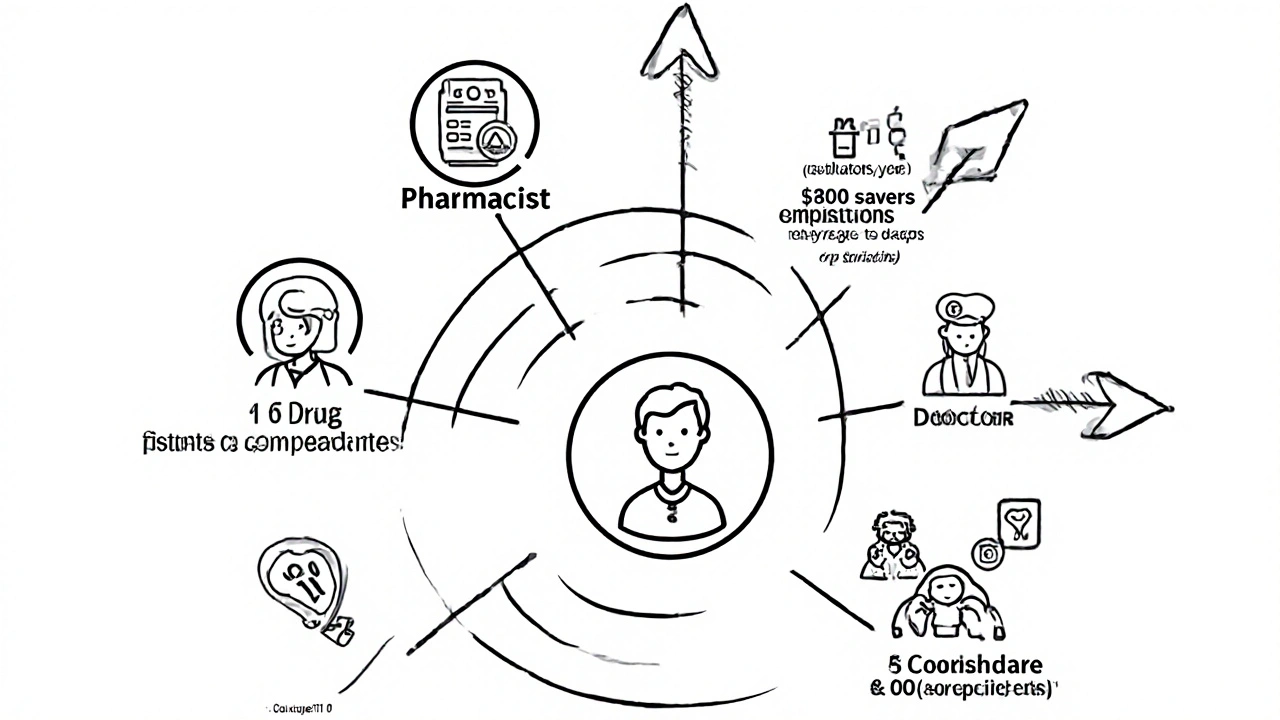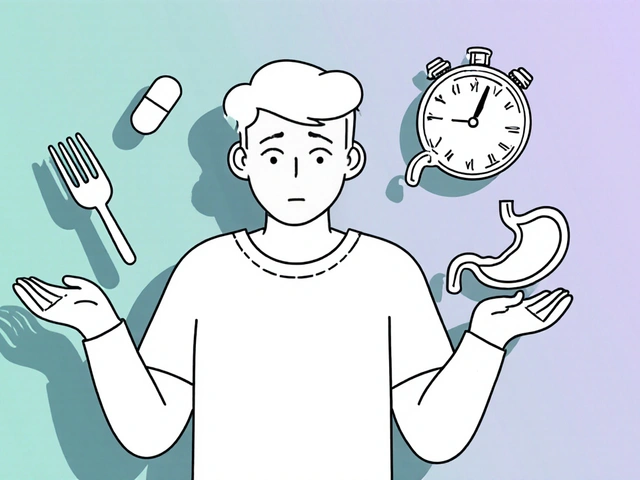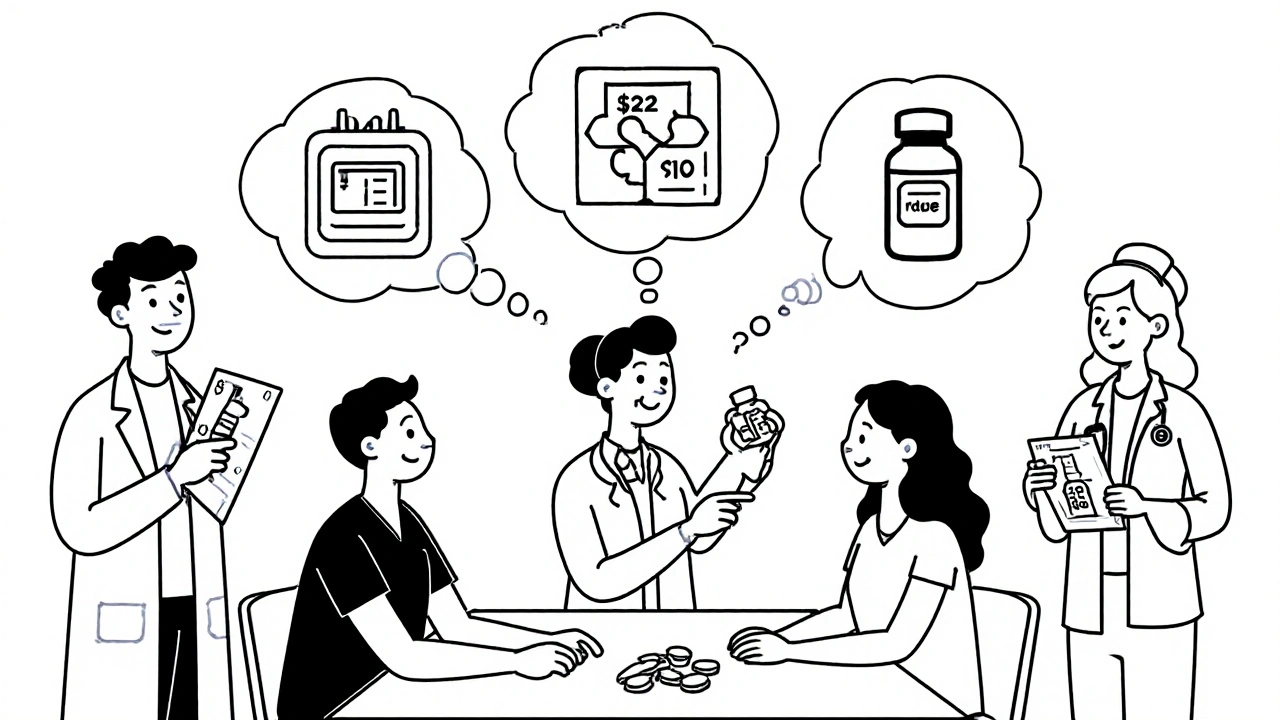When a patient walks into a clinic with five prescriptions, high blood pressure, diabetes, and a $300 monthly drug bill, who’s really in charge of their medication plan? It’s not just the doctor. It’s not just the pharmacist. It’s the whole team working together - and that’s where team-based care changes everything.
What Team-Based Care Really Means for Prescribing
Team-based care isn’t a buzzword. It’s a system where doctors, pharmacists, nurses, and care coordinators share responsibility for a patient’s medication plan. The National Academy of Medicine defined it clearly in 2017: it’s about coordinated, patient-centered care that brings the right people together at the right time. In prescribing, that means moving away from the old model - where one doctor writes a script and hopes the patient fills it - to a structured process where every member has a defined role.Pharmacists don’t just count pills. They’re trained to spot drug interactions, check for therapeutic duplication, and recommend generic alternatives that work just as well but cost a fraction. Nurses track blood pressure trends and remind patients about refills. Care coordinators make sure the specialist’s notes reach the primary care provider. And the doctor? They focus on complex decisions - adjusting insulin doses, diagnosing new conditions - while the team handles the routine but critical stuff.
Why Generic Prescribing Works Better in Teams
Generic drugs are safe, effective, and often 80% cheaper than brand names. But patients don’t always switch - even when it’s the right move. Why? Fear. Confusion. Lack of explanation. In a traditional visit, a doctor might say, “I’m switching you to lisinopril,” and move on. In a team-based model, the pharmacist sits down with the patient and explains: “This is the same medicine as Prinivil, but it costs $12 instead of $120. Here’s how it works. Here’s what to watch for.”Studies show this approach works. One 2023 analysis from PureView Health Center found that team-based medication management led to $1,200-$1,800 in annual savings per patient - mostly from switching to generics and avoiding avoidable hospitalizations. Another study in the National Center for Biotechnology Information (PMC3551433) found that when pharmacists were integrated into care teams, generic substitution rates jumped by 40% without any drop in clinical outcomes.
It’s not just about cost. It’s about adherence. When patients understand why a cheaper pill is just as good, they’re more likely to take it. And when pharmacists document those conversations in the electronic health record, the whole team stays on the same page.
The Roles: Who Does What in a Medication Team
Every effective team has clear roles. Here’s how they break down:- Physicians: Diagnose, manage complex conditions, approve final medication changes, and oversee the team’s recommendations.
- Pharmacists: Conduct comprehensive medication reviews, identify drug interactions, recommend generics, educate patients, and manage Medication Therapy Management (MTM) services.
- Nurses and Medical Assistants: Monitor chronic conditions (blood pressure, glucose, weight), provide adherence counseling, and handle preventive care tasks like flu shots and screenings.
- Care Coordinators: Connect the dots between specialists, pharmacies, and home care. They track referrals, schedule follow-ups, and make sure no one falls through the cracks.
These roles aren’t optional. A 2022 CDC report found that practices using Collaborative Practice Agreements (CPAs) - formal contracts that let pharmacists adjust medications under physician supervision - saw 35% faster medication reconciliation and 22% fewer duplicate tests.
Real Results: Numbers That Matter
Numbers don’t lie. Here’s what team-based care delivers in real-world settings:- 67% reduction in medication errors (American Pharmacists Association, 2022)
- 28% improvement in medication adherence (APhA, 2022)
- 17.3% fewer hospital readmissions (ThoroughCare, 2022)
- 42% more patients switched to generics after pharmacist-led counseling (SICHC case study, 2022)
- $1,200-$1,800 annual savings per patient (PureView Health Center, 2023)
One patient on Healthgrades wrote: “The pharmacist caught three interactions my doctor missed and switched me to generics that saved me $200 monthly.” That’s not luck. That’s a system working.

Challenges: Why It’s Not Everywhere Yet
Despite the benefits, team-based care still isn’t the norm. Why?Cost is a big one. Setting up the infrastructure - hiring pharmacists, training staff, upgrading EHRs - can run $85,000 to $120,000 per practice, according to VA Health Services Research (2021). Smaller clinics can’t afford it alone.
Then there’s culture. Many physicians grew up in a system where they made all the calls. Letting a pharmacist recommend a generic can feel like losing control. But the data shows the opposite: when doctors delegate routine decisions, they have more time for complex cases. One physician on Reddit said his team cut his medication management time by 30% after bringing in a pharmacist.
Technology gaps are another hurdle. If the pharmacist’s notes don’t show up in the doctor’s EHR, or if the care coordinator can’t reach the specialist, the system breaks. A 2022 Commonwealth Fund review found 12% of negative patient experiences came from communication breakdowns between team members.
How to Build a Team-Based Prescribing System
You don’t need a hospital system to start. Here’s a realistic 6-month plan:- Months 1-2: Define roles. Who does what? Draft a simple Collaborative Practice Agreement (CPA) with your local pharmacist. Use CDC templates.
- Months 3-4: Train your team. Pharmacists need 16-24 hours of training on EHR documentation and MTM protocols. Nurses should learn how to flag high-risk patients.
- Month 5: Pick your first 20 patients. Target those with 3+ chronic conditions, 5+ medications, and high drug costs - the exact criteria Medicare Part D uses.
- Month 6: Launch with daily 15-minute huddles. Review each patient’s meds. Track what worked. Fix what didn’t.
Start small. Focus on one condition - say, hypertension. Use generic ACE inhibitors. Track blood pressure trends. Measure savings. Then expand.
The Future: AI, Telepharmacy, and Expanding Access
The field is evolving fast. In 2023, CMS lowered the Medicare Part D eligibility threshold from five to four medications - adding 4.2 million more people to team-based programs. Telepharmacy is booming: 214% growth between 2020 and 2023, according to the American Telemedicine Association. Now, patients in rural towns can get pharmacist-led medication reviews over video.AI is stepping in too. Mayo Clinic’s pilot program used AI to suggest generic alternatives based on patient history and cost data. The result? 22% more appropriate generic switches and 9.3% fewer adverse events.
But the biggest shift isn’t technological. It’s cultural. More healthcare leaders are recognizing that prescribing isn’t a solo act. It’s a team sport. In a 2023 survey by the Advisory Board Company, 92% of executives said they plan to expand team-based medication services.

When It Doesn’t Work
Team-based care isn’t magic. It doesn’t replace the doctor. It doesn’t work well for acute emergencies. If a patient shows up with chest pain, you don’t wait for a team huddle. You act.And there’s risk. Dr. Richard Baron, former CEO of the American Board of Internal Medicine, warned in JAMA that over-reliance on non-physician team members can lead to errors - especially in complex cases. A 2021 study found a 5.2% error rate in medication recommendations from non-physician staff when oversight was weak.
The fix? Clear boundaries. Pharmacists recommend. Doctors approve. Nurses monitor. Everyone documents. Trust is built through consistency, not authority.
What Patients Say
Patient reviews tell the real story. On Healthgrades, practices with team-based medication management average 4.7 out of 5 stars. Comments like:- “I used to skip my meds because they were too expensive. Now I take them every day.”
- “The pharmacist spent 20 minutes with me. My doctor never had time.”
- “I didn’t know I could get the same drug for $15. Thank you for asking.”
These aren’t marketing slogans. They’re proof that when you treat prescribing as a team effort, patients get better outcomes - and feel heard.
Final Thought: It’s Not About Who Prescribes - It’s About Who Cares
The goal isn’t to replace doctors with pharmacists. It’s to make sure no one falls through the cracks. A patient with diabetes shouldn’t need to remember to ask for a cheaper pill. The system should catch it.Team-based care turns generic prescribing from a transaction into a conversation. It turns cost savings into better health. And it turns fragmented care into something that actually works.
Can pharmacists legally prescribe generic medications in team-based care?
Yes, but only under formal Collaborative Practice Agreements (CPAs) that outline their scope of authority. These agreements are signed by both the pharmacist and a supervising physician and are recognized in 49 states. Pharmacists can adjust dosages, switch to generics, or initiate therapy for stable chronic conditions - but they can’t diagnose new diseases or manage complex, unstable cases without physician approval.
What types of patients benefit most from team-based generic prescribing?
Patients with three or more chronic conditions (like diabetes, hypertension, and high cholesterol), taking five or more medications, and spending over $4,000 annually on drugs benefit the most. These are the exact criteria used by Medicare Part D’s Medication Therapy Management (MTM) program. They’re also the patients most likely to experience drug interactions, poor adherence, or financial toxicity - all of which team-based care directly addresses.
Is team-based care more expensive for clinics to run?
Initial setup costs are high - $85,000 to $120,000 per practice - but long-term savings outweigh them. A 2023 analysis found team-based models saved $1,200-$1,800 per patient annually by reducing hospitalizations and unnecessary tests. Many practices recoup their investment within 18 months. Medicare and Medicaid now reimburse for MTM services, and private insurers are following suit.
Do generic drugs work as well as brand names in team-based care?
Yes. The FDA requires generics to have the same active ingredient, strength, dosage form, and route of administration as the brand name, and to be bioequivalent - meaning they work the same way in the body. Studies consistently show no difference in clinical outcomes. In team-based care, pharmacists educate patients on this equivalence, which increases acceptance and adherence.
How do you know if your practice is ready for team-based prescribing?
Ask these questions: Do you have patients with complex medication regimens? Do you spend too much time on refill requests or drug interactions? Are your staff frustrated by communication gaps? If yes, you’re ready. Start by partnering with a local pharmacist, using CDC’s CPA template, and targeting your top 10 high-cost, high-complexity patients. Track results for 90 days. If adherence improves and costs drop, scale up.



